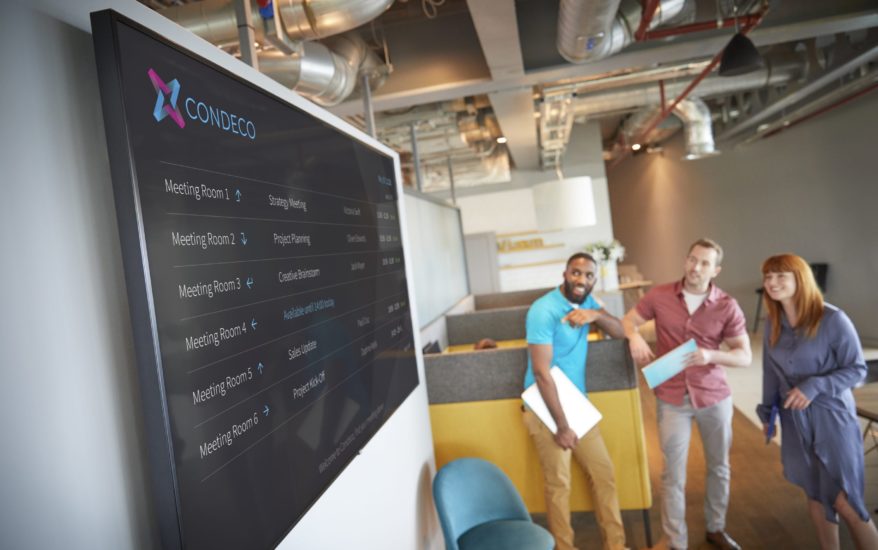
Wayfinding is one of those elements of the built environment that you don’t notice if it’s working well – but is painfully obvious if it’s not. Whether it’s an office, a museum, a hospital or a shopping center, good wayfinding helps visitors find places quickly, and with digital solutions, it can make an office truly flexible.
What is Wayfinding?
Wayfinding is signposting and directional information, and can be boiled down to just four factors:
- Where you are now
- Where you’re going or what’s available
- Deeper information on your location
- Warnings, safety and instructions
The aim is to move people to where they want to go quickly and efficiently by clarifying decision points. Sometimes, they might not know where they want to go yet, for example in a shopping precinct. It can be used to map out options and give information on them.
Wayfinding principles
Wayfinding design should obey certain principles if it is to be understood and used to its strengths. It should be:
Clear: There should be no more and no less information than is immediately needed. Wayfinding graphics should be bold and recognisable, and text should be in a simple, easy to read typeface. Key information should be readable from a relevant distance.
Useful: The information displayed should be of use to anyone seeing it. Pointless signage just complicates matters.
Consistent: All the signs within a building or project should follow consistent style guidelines. It’s OK to have different departments or areas in different colours (in fact it can be helpful). But there should be an underlying style that’s obeyed throughout.
Inclusive: Using simple language means anyone, whatever their education or nationality, can understand signs. It should be visible, audible and tactile where possible, for those in wheelchairs, the hard of hearing and people with visual impairments.
What is a wayfinding kiosk?
A wayfinding kiosk is an interactive, screen-based device that lets people take control of their visit to a location. They perform a key role because visitors can use its maps, expanded information and search functions to identify their current location and find the place they want to go to. Interactive wayfinding screens or kiosks are often found in key movement hubs such as main entrances and landings by lifts and staircases. They can also be dotted around complex spaces, such as large shopping developments and exhibitions, or large workplaces.
There are many benefits of a wayfinding kiosk, but a successful one can remove the need for a reception or information desk altogether, with obvious cost implications. Usually, however, they work in concert with a reception, as human contact is often necessary or desirable.
The benefits of digital Wayfinding
While there have always been direction and identification signs on walls, floor graphics and hanging signs, they have been static and inflexible. Digital wayfinding is a modern solution, and it’s dramatically changing large offices and shared workspaces.
The system relies on screens to display information. Sometimes these can have interactive tablet-type interfaces so that visitors can expand information, but the ones on display usually show fixed messaging, as they are shared by everyone in the area. (Kiosks serve interactivity better.)
People who have worked in a standard office for a few weeks usually pick up where everything is, so rely on their mental map eventually. However, new employees, guests, and visitors rely on it completely to get about. And while that all applies to a traditional office, permanent signage can find itself lacking in a flexible workspace.
Digital wayfinding is responsive, so names and numbers of rooms can change, their occupancy can be updated live, and any extra information relevant to the room’s current use can be displayed. That makes it an essential for the modern office.
Digital wayfinding is responsive, so names and numbers of rooms can change, their occupancy can be updated live, and any extra information relevant to the room’s current use can be displayed. That makes it an essential for the modern office.
Wayfinding hardware
The technology in Condeco’s suite of solutions for office spaces includes:
- Meeting room screens: With one mounted outside each meeting room, it displays the name of the current/next meeting and whether the room is occupied or vacant.
- Desk booking kiosks: On entry to a shared desk space, workers can find a vacant desk and book it for now or later.
- Desk booking screens: Small screens, about the size of a drinks coaster, that sit on the edge of the table and light up green or red to show availability or occupancy. Integrates automatically with desk booking kiosks.
- Meeting room wayfinders: A mixture of large lobby screens and smaller room screens, this integrated display solution is constantly updated and keeps visitors and employees moving to where they’re going efficiently.
Wayfinding software
All of Condeco’s office wayfinding solutions are fed from a central cloud-based database that ensures real-time information displayed on each screen is relevant and up to date. Administrators can easily access all the data, and find the exact use of any space for any given time in the past, present or future.
The system uses WiFi to keep all the screens working together. From the large lobby screens directing new arrivals to the desk booking screens that change color the moment their status changes, it’s all connected.
The final piece of the jigsaw is the mobile app. That means anyone can interact with the cloud-based system from anywhere in the world. Users can book a desk space from their breakfast table, and reschedule a meeting room slot from the delayed train.



